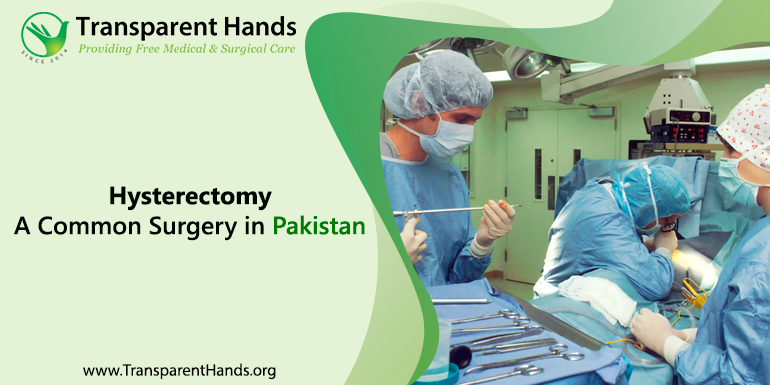Hysterectomy: A common Surgery in Pakistan

Hysterectomy is the removal of the uterus via surgical intervention to cure or prevent a number of medical conditions. It is one of the most common surgeries in Pakistan and is often preventable. Conditions that lead to hysterectomies can be managed but they often go unnoticed due to lack of awareness. Often, by the time symptoms appear, removing the uterus is the only effective treatment.
Why Hysterectomy?
There are a number of medical conditions that make hysterectomy necessary in the interest of the health of the patients. Some of these conditions include:
Ovarian Cancer
Ovarian cancer is a potentially fatal medical condition if it goes unnoticed. Symptoms of ovarian cancer include abdominal bloating, weight loss, fatigue, backaches, fluctuation in bowel habits, and urges to urinate.
The human female reproductive system has two ovaries and when the cancer is localized to one ovary it is known as unilateral cancer and if both ovaries are affected it is called bilateral ovarian cancer. Treatment of the condition depends on the severity and location of the cancer.
If the cancer is localized and narrow it can be managed with conservative surgeries and chemotherapy. A hysterectomy is needed if the cancer is spreading too fast and is not localized to a narrow region.
Uterine Fibroids
It is a condition when noncancerous tumors begin to grow inside the uterus. The condition can cause pain and heavy bleeding which can lead to anemia. Consequently, patients can develop a number of other conditions as well. Physicians try to manage the condition by prescribing hormonal drugs and certain coagulants. But if the medicine fails to manage the condition hysterectomy has to be performed.
Uterine Fibroids Guide For Women
Pelvic Infection
An infection in areas surrounding the uterus can also require a hysterectomy. It is associated with excruciating pain, bleeding, and swelling in the region. At times when the infection is too severe, it can damage the uterus’ tissue. Leaving the necrotic tissue inside the body can cause a number of fatal medical conditions. Hence, the physicians would try to prevent the damage by prescribing some antibiotics. But if they do not work, surgeons have to intervene and perform a hysterectomy.
Other conditions that may require it include:
- Abnormal uterine bleeding
- Uterine leiomyomas
- Premalignant disease
- Chronic pelvic pain
- Endometriosis
- Uterine prolapse
Types of Hysterectomy
Hysterectomy can be divided into further types based on the extent and organs that are removed. The choice of the type depends on the kind and severity of medical conditions.
Total Hysterectomy
As the name indicates, this type of hysterectomy removes the entire uterus. It is most commonly performed on patients that are past menopause.
Subtotal Hysterectomy
This type of hysterectomy removes the uterus but leaves the cervix in place.
Total Hysterectomy with Bilateral Salpingo-oophorectomy
This surgery involves the removal of the uterus, cervix, fallopian tubes, and ovaries. It is usually performed on patients with malignant tumors in the reproductive system.
Radical Hysterectomy
Radical Hysterectomy is the most extensive surgery that involves removal of the vagina as well in addition to the uterus, fallopian tubes, ovaries, and lymph glands. Surgeons perform this surgery when cancer has grown significantly and has also spread to surrounding lymph nodes.
Routes of Hysterectomy
Previously the only route to perform a hysterectomy was through the abdomen, a technique similar to C-Section. But with technological advancement, it can be done without cutting through the abdomen.
Laparoscopic Route
Laparoscopic surgery involves small incisions in the abdomen of the patient and removal of the uterus through those incisions. The uterus is cut into several pieces and taken out through those tiny holes. It leaves minimal surgical marks and the recovery is also rapid.
Vaginal Route
With this technique, small cuts are made at the top of the vagina and the uterus is removed in pieces. Patients’ recovery with this technique is fast as well.
Complication of Hysterectomy
Hysterectomy is generally considered a safe procedure but there are certain risks nonetheless. These include:
- Bleeding
- Surgical site infection
- Hospital-acquired infection
- Allergic reaction to anesthesia
- Damage to nearby organs
Life After Hysterectomy
Hysterectomies are done by assessing the risk-to-benefit ratio and only when physicians deem it necessary. Even though it saves the patient from potentially fatal conditions, it comes at the expense of certain compromises. For example:
- Patients who undergo hysterectomy along with the removal of ovaries cannot get pregnant.
- Patients immediately go into menopause.
- Hormonal changes
Recovery Time
Recovery time after the hysterectomy depends on the type of technique used and the extent of removal. But in any case, it is a major medical procedure that requires the patients to be admitted to a hospital at least for a few days.
Can Hysterectomy Be Avoided?
Some conditions like Uterine Fibroids, if detected before progression, can be managed via medications. But it is important that the condition is detected in the early stages. In such cases, hysterectomies can be avoided, or at least the surgery can be delayed for a few years.
Bottom Line
Hysterectomy is a surgical procedure that is common in Pakistan. It is carried out for a number of conditions and sometimes renders the patient infertile. Transparent Hands provides hysterectomies to deserving patients free of charge.
However, we need your support to do so. Please donate generously.










Leave Your Comments